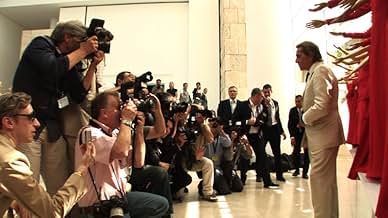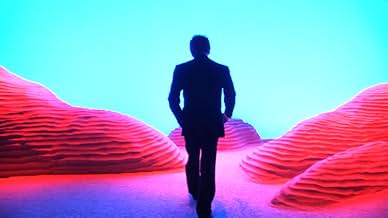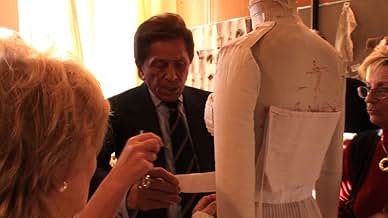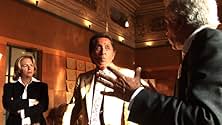VALUTAZIONE IMDb
7,1/10
1962
LA TUA VALUTAZIONE
Aggiungi una trama nella tua linguaA look at the life of legendary fashion designer Valentino.A look at the life of legendary fashion designer Valentino.A look at the life of legendary fashion designer Valentino.
- Premi
- 2 vittorie e 6 candidature totali
Nati Abascal
- Self
- (as Naty Abascal)
Recensioni in evidenza
This documentary follows legendary fashion designer Valentino Garavani from 2006 to his 45th anniversary show in 2007. Everybody suspects his long career is coming to a close and they keep asking him about retirement. Financial and business considerations are also forcing him to face that reality. He has longtime partner Giancarlo Giammetti, his countless supporters, and his tiny dogs. It's a movie for fashion and Valentino fans. The most compelling is Valentino working on the dress with his many associates, the half dozen older ladies working on the design, and the statuesque blonde walking back and forth. It's always nice to see someone using his brain to create something original. The rest is not that interesting and the business aspect provides no tension.
10meininky
I love when people are really, deeply passionate about something. While I'm not a big fan of sports, I love to listen to my friends give the details of their latest game or match; even though the actual event isn't particularly interesting to me, the fact that it means so much to someone (especially someone close to me) makes it far more interesting. Valentino: The Last Emperor shows a man who is passionate about fashion; he never thought of being a firefighter or anything else. Even in the midst of financial shuffling and lavish celebrations, Valentino never loses sight of why he does what he does: he wants to make beautiful clothes for beautiful women.
And his passion is contagious. After a show, he is greeted by fans who are in tears at the sheer genius of what they see on the runway. It's impossible not to be as impressed as they are; while the fashion, in this film, takes a backseat to the man himself, it is still breath- taking. Just as Ratatouille allows you to brush with what it means to love food on a deeper lover, so this film allows a glimpse into what it means to really love fashion.
Of course, fashion isn't the only thing on display here; Valentino himself is a fascinating subject for a documentary. On one hand, he's a genius. On the other, he's a diva (though it really isn't that surprising that those two go hand-in-hand). The little moments this film shows--the glimpses of Valentino's everyday life--provide a sense of a life that seems like it's from another planet. A model getting her hair done reads about Einstein. Five pugs line up on the seats of a private jet. Valentino tells his partner and lover Giancarlo Giametti that the design for a stage isn't right, mere hours before the show must go on.
Yet, even with the tantrums and mood swings (at times, Valentino yells at the cameraman, providing a strange sense of reality TV), you get the sense that Valentino really hasn't been affected by the power and money he's accumulated over the years. He simply wants to make sure that his work is presented in the best way possible. And what work it is. At the celebration of Valentino's 45 year career, his dresses line the walls, sit atop columns, and rest within glass cubes. Each piece represents a time so perfectly, because no designer is as important or relevant as Valentino.
As much as the film celebrates his past, Valentino's future is also discussed to a great degree. The question is asked: who can follow in Valentino's footsteps, when he inevitably retires? The answer is obvious: nobody can. There's only one Valentino, the Last Emperor of fashion.
And his passion is contagious. After a show, he is greeted by fans who are in tears at the sheer genius of what they see on the runway. It's impossible not to be as impressed as they are; while the fashion, in this film, takes a backseat to the man himself, it is still breath- taking. Just as Ratatouille allows you to brush with what it means to love food on a deeper lover, so this film allows a glimpse into what it means to really love fashion.
Of course, fashion isn't the only thing on display here; Valentino himself is a fascinating subject for a documentary. On one hand, he's a genius. On the other, he's a diva (though it really isn't that surprising that those two go hand-in-hand). The little moments this film shows--the glimpses of Valentino's everyday life--provide a sense of a life that seems like it's from another planet. A model getting her hair done reads about Einstein. Five pugs line up on the seats of a private jet. Valentino tells his partner and lover Giancarlo Giametti that the design for a stage isn't right, mere hours before the show must go on.
Yet, even with the tantrums and mood swings (at times, Valentino yells at the cameraman, providing a strange sense of reality TV), you get the sense that Valentino really hasn't been affected by the power and money he's accumulated over the years. He simply wants to make sure that his work is presented in the best way possible. And what work it is. At the celebration of Valentino's 45 year career, his dresses line the walls, sit atop columns, and rest within glass cubes. Each piece represents a time so perfectly, because no designer is as important or relevant as Valentino.
As much as the film celebrates his past, Valentino's future is also discussed to a great degree. The question is asked: who can follow in Valentino's footsteps, when he inevitably retires? The answer is obvious: nobody can. There's only one Valentino, the Last Emperor of fashion.
"Valentino: The Last Emperor" is an interesting look at the Valentino empire and the changing times in which it exists. It follows Valentino and his partner in life and work, Giancarlo Giametti, as they prepare for a show and later, Valentino's 45 anniversary as a designer.
The fluff stuff first - the fashions are amazing. Valentino designs a beautiful white gown at one point, and we watch his critique of the finished product, and whether or not to add sequins and extra panels. We also see some of the people for whom he has designed over the years: Princess Diana, Jacqueline Kennedy, Audrey Hepburn, and Gwyneth Paltrow, to name only a few. And we see a lot of his signature red gowns. Also, as a second comment on the fluff, Valentino, Giametti and their many pug dogs live like kings, with magnificent homes everywhere!
The more serious undertone in this documentary is the changing world of fashion and what has become the business of fashion. There are interviews throughout about this - the world today is about the bottom line, which means scents, designer handbags, and other accessories. The couture isn't the big moneymaker, but it is what Valentino has devoted his life to. As an artist who is proud of his work and committed to it, we see increasingly that the businessmen are less interested in Valentino the artist and more interested in Valentino the brand. It's a world he no longer belongs in.
The best parts of this film for me were the times when Valentino was watching the gowns on the models and making decisions on changes - truly the artist at work. That kind of devotion to detail is so rare today. It was a joy to watch.
You probably won't learn much about the man himself here, but you will learn something about his work -- and as an artist in the truest sense, that is Valentino's true essence.
The fluff stuff first - the fashions are amazing. Valentino designs a beautiful white gown at one point, and we watch his critique of the finished product, and whether or not to add sequins and extra panels. We also see some of the people for whom he has designed over the years: Princess Diana, Jacqueline Kennedy, Audrey Hepburn, and Gwyneth Paltrow, to name only a few. And we see a lot of his signature red gowns. Also, as a second comment on the fluff, Valentino, Giametti and their many pug dogs live like kings, with magnificent homes everywhere!
The more serious undertone in this documentary is the changing world of fashion and what has become the business of fashion. There are interviews throughout about this - the world today is about the bottom line, which means scents, designer handbags, and other accessories. The couture isn't the big moneymaker, but it is what Valentino has devoted his life to. As an artist who is proud of his work and committed to it, we see increasingly that the businessmen are less interested in Valentino the artist and more interested in Valentino the brand. It's a world he no longer belongs in.
The best parts of this film for me were the times when Valentino was watching the gowns on the models and making decisions on changes - truly the artist at work. That kind of devotion to detail is so rare today. It was a joy to watch.
You probably won't learn much about the man himself here, but you will learn something about his work -- and as an artist in the truest sense, that is Valentino's true essence.
A wonderful portrait, displays several sides of Valentino from Emperor to flawed human like the rest of us. The artist, the opulent lifestyle, the dedicated partnership with his lover, the changing of the fashion business and its ramifications on this aging lion and the reality he created.
Music for the movie was perfectly selected, very well executed, edited and beautiful cinematography. This film was inspiring, funny, and touching. If your lucky enough to have Valentino in your city, hurry to the theater as it is a must see. What comes after Valentino? As he says, "The flood".
Music for the movie was perfectly selected, very well executed, edited and beautiful cinematography. This film was inspiring, funny, and touching. If your lucky enough to have Valentino in your city, hurry to the theater as it is a must see. What comes after Valentino? As he says, "The flood".
Director Matt Tyrnauer never could have known when making his new documentary "Valentino: The Last Emperor" that he'd first chronicle the demise of fashion's last true self-made couturier and then release it into a world where, as former Valentino Fashion Group president Matteo Marzotto (and the film's antagonist) recently declared flatly, "luxury is over." Resisting the reality-genre conventions a 21st Century first-timer might be tempted to devolve into in shaping events to fit a narrative arc, Tyrnauer simply lifts the curtain on Valentino's gorgeous, frantic, fragile universe and watches it collapse; a dying star, shining brightest as it implodes.
What began as an outgrowth of a feature story written by Tyrnauer at Vanity Fair, where he is Special Correspondent, "Valentino: The Last Emperor" vaults over similar documentary efforts that fell back on partial scripting (Madonna's 1991 "Truth or Dare") or the discomfiting exploitation of a soon-to-fail relationship (the 1995 Isaac Mizrahi doc "Unzipped," directed by Mizrahi's unseen/all-seeing boyfriend Douglas Keeve). The reasons for this success stem directly from the trust placed in Tyrnauer, who as part of the 2004 Vanity Fair piece effectively managed what Valentino's own PRs certainly could not: the news -- subsequently splashed across European broadsheets -- that Valentino and Giancarlo Giammetti, Valentino's multi-role partner, were gay and had been lovers for 12 years as part of their decades-long relationship.
Five years later, while Italian homosexuality remains a specifically complicated knot to unravel, a paradigm shift has occurred. The presupposition that the men are gay, as are the majority of their peers and male colleagues, is a mute presence in the film, while the expressive energy of the men's post-sexual relationship drives the film and their careers equally.
Despite their bickering, their constant manipulations and mutual interferences, and the unceasing Italianness of their relationship (in one priceless moment, Giammetti stops Valentino cold in the middle of berating his partner's design choices by telling him he has a belly), what makes the center of the film is their love of one another, their love of fighting one another, and their love of being slightly put-upon by the demands of the baroque splendor of their lives together; lives made together, for each other. Unable as part of their generation, as part of La Dolce Vita in the closet, unable to be the men they (or their families) might have wanted them to be, their passions manifested in the exquisite beauty of Valentino's oeuvre and the extensive wealth that Giammetti was able to amass for them from it. Enough beauty, wealth and fame on an international (Jackie, Uma, all of them in between) scale to live, as Giammetti astutely observes, "above."
Valentino is "above control, above partnership" and above, for most of his career, the closet. No wonder Valentino seems happy only when Tyrnauer shows him in the mountains in Gstaad, skiing -- above indeed -- informally dressed for once, alone and beckoning Giammetti to come to him from afar. Both men seem to know, semi-consciously, that separately neither man would have been able to achieve a tenth of what they've done as a couple. In what has rightly been termed their "love story," 1 + 1 = 1,000.
The film has had the bittersweet luck to have been present for the ascendancy of a new math, as European equity fund Permira makes successive hostile takeover plays for Valentino's eponymous house, a late-capitalism tsunami of Euros sweeping away Valentino and Giammetti on the eve of elaborate celebrations and the designer's swansong show. Profit margins through duty-free handbags and trading on Valentino's name are the only products of these harsh calculations, whose cold logic is revealed later to show no mercy to the mercenaries brought in to do Permira's bidding. Tyrnauer, whose deft cameraman is seemingly everywhere at once thanks to top-shelf editing, wryly shows how these backstage machinations among unspeakable grandeur serve to further compress the schedule and increase the opulence of Valentino's farewell and farewell collection. Here, the film spends as much time in the château with Joan Collins and the Comtesse de Ribes as it does tender, thoughtful time with the house's incredible team of harried and largely unsung seamstresses. Hand-stitching be damned, the new regime looms, and Valentino's house, the last of its kind, will soon float away like the ironically apt motif of the hot air balloon chosen for the final season. It rises, lingers beautifully, and inevitably floats out of reach. As Giammetti says in closing the celebration and the film, "It was beautiful." He says more than he'll ever know.
As multiple fashion luminaries comment throughout the film, the end of Valentino is the end of couture. (Lagerfeld and Armani seem to be out of competition, and aren't couturiers per se.) The current economic turmoil and the underlying social upheaval it implies have sealed present-day couture's fate for good. Conspicious consumption and the chicanery that funds it is done for a generation or more. Italy's crown jewel industry is in tatters, waiting for government handouts; multiple fashion houses are ruined. Permira's wager on raping the name that Valentino and Giammetti built over 50 years has been called in at the sum of hundreds of millions of Euros when it recently wrote down much of the value of Valentino Fashion Group. We'll go back -- hopefully -- to a time when fashion becomes a meritocracy again and conglomerate oligarchs have no place in whatever remains of haute couture. Valentino and Giammetti have left the party with one final, masterful flourish; Tyrnauer begins a new career having been there to capture its glory. It was beautiful.
What began as an outgrowth of a feature story written by Tyrnauer at Vanity Fair, where he is Special Correspondent, "Valentino: The Last Emperor" vaults over similar documentary efforts that fell back on partial scripting (Madonna's 1991 "Truth or Dare") or the discomfiting exploitation of a soon-to-fail relationship (the 1995 Isaac Mizrahi doc "Unzipped," directed by Mizrahi's unseen/all-seeing boyfriend Douglas Keeve). The reasons for this success stem directly from the trust placed in Tyrnauer, who as part of the 2004 Vanity Fair piece effectively managed what Valentino's own PRs certainly could not: the news -- subsequently splashed across European broadsheets -- that Valentino and Giancarlo Giammetti, Valentino's multi-role partner, were gay and had been lovers for 12 years as part of their decades-long relationship.
Five years later, while Italian homosexuality remains a specifically complicated knot to unravel, a paradigm shift has occurred. The presupposition that the men are gay, as are the majority of their peers and male colleagues, is a mute presence in the film, while the expressive energy of the men's post-sexual relationship drives the film and their careers equally.
Despite their bickering, their constant manipulations and mutual interferences, and the unceasing Italianness of their relationship (in one priceless moment, Giammetti stops Valentino cold in the middle of berating his partner's design choices by telling him he has a belly), what makes the center of the film is their love of one another, their love of fighting one another, and their love of being slightly put-upon by the demands of the baroque splendor of their lives together; lives made together, for each other. Unable as part of their generation, as part of La Dolce Vita in the closet, unable to be the men they (or their families) might have wanted them to be, their passions manifested in the exquisite beauty of Valentino's oeuvre and the extensive wealth that Giammetti was able to amass for them from it. Enough beauty, wealth and fame on an international (Jackie, Uma, all of them in between) scale to live, as Giammetti astutely observes, "above."
Valentino is "above control, above partnership" and above, for most of his career, the closet. No wonder Valentino seems happy only when Tyrnauer shows him in the mountains in Gstaad, skiing -- above indeed -- informally dressed for once, alone and beckoning Giammetti to come to him from afar. Both men seem to know, semi-consciously, that separately neither man would have been able to achieve a tenth of what they've done as a couple. In what has rightly been termed their "love story," 1 + 1 = 1,000.
The film has had the bittersweet luck to have been present for the ascendancy of a new math, as European equity fund Permira makes successive hostile takeover plays for Valentino's eponymous house, a late-capitalism tsunami of Euros sweeping away Valentino and Giammetti on the eve of elaborate celebrations and the designer's swansong show. Profit margins through duty-free handbags and trading on Valentino's name are the only products of these harsh calculations, whose cold logic is revealed later to show no mercy to the mercenaries brought in to do Permira's bidding. Tyrnauer, whose deft cameraman is seemingly everywhere at once thanks to top-shelf editing, wryly shows how these backstage machinations among unspeakable grandeur serve to further compress the schedule and increase the opulence of Valentino's farewell and farewell collection. Here, the film spends as much time in the château with Joan Collins and the Comtesse de Ribes as it does tender, thoughtful time with the house's incredible team of harried and largely unsung seamstresses. Hand-stitching be damned, the new regime looms, and Valentino's house, the last of its kind, will soon float away like the ironically apt motif of the hot air balloon chosen for the final season. It rises, lingers beautifully, and inevitably floats out of reach. As Giammetti says in closing the celebration and the film, "It was beautiful." He says more than he'll ever know.
As multiple fashion luminaries comment throughout the film, the end of Valentino is the end of couture. (Lagerfeld and Armani seem to be out of competition, and aren't couturiers per se.) The current economic turmoil and the underlying social upheaval it implies have sealed present-day couture's fate for good. Conspicious consumption and the chicanery that funds it is done for a generation or more. Italy's crown jewel industry is in tatters, waiting for government handouts; multiple fashion houses are ruined. Permira's wager on raping the name that Valentino and Giammetti built over 50 years has been called in at the sum of hundreds of millions of Euros when it recently wrote down much of the value of Valentino Fashion Group. We'll go back -- hopefully -- to a time when fashion becomes a meritocracy again and conglomerate oligarchs have no place in whatever remains of haute couture. Valentino and Giammetti have left the party with one final, masterful flourish; Tyrnauer begins a new career having been there to capture its glory. It was beautiful.
Lo sapevi?
- QuizAs told to Elvis Mitchell on KCRW's The Treatment (May 6, 2009), Director Matt Tyrnauer recounted that the film almost never made it to a commercial release. Both Giancarlo and Valentino hated the film on first viewing during a private screening in London and "were completely in shock". Although Tyrnauer had final cut, it took him over five months of negotiations before finally showing the film at the Venice film festival. At Venice the entire audience stood and gave a standing ovation to Valentino after the screening and Valentino apparently now loves the film.
- BlooperIn the closing credits, the archival footage from ZIEGFELD GIRL is credited as a "Warner Brothers" movie. It was an MGM movie but is released on home video by Warner Home Video.
- Citazioni
scenographer: Well, we don't want to have nasty rails do we?
- ConnessioniFeatures La dolce vita (1960)
I più visti
Accedi per valutare e creare un elenco di titoli salvati per ottenere consigli personalizzati
- How long is Valentino: The Last Emperor?Powered by Alexa
Dettagli
- Data di uscita
- Paese di origine
- Siti ufficiali
- Lingue
- Celebre anche come
- Valentino: The Last Emperor
- Luoghi delle riprese
- Azienda produttrice
- Vedi altri crediti dell’azienda su IMDbPro
Botteghino
- Lordo Stati Uniti e Canada
- 1.755.134 USD
- Fine settimana di apertura Stati Uniti e Canada
- 21.762 USD
- 22 mar 2009
- Lordo in tutto il mondo
- 2.203.403 USD
- Tempo di esecuzione
- 1h 36min(96 min)
- Colore
- Mix di suoni
- Proporzioni
- 1.85 : 1
Contribuisci a questa pagina
Suggerisci una modifica o aggiungi i contenuti mancanti




































